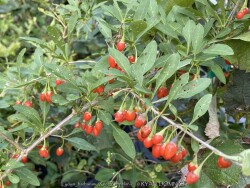

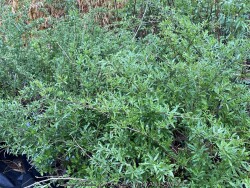
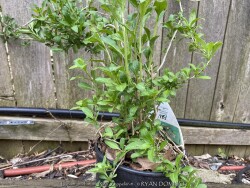
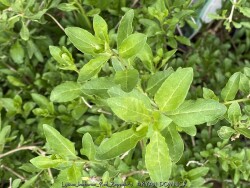
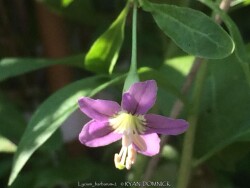
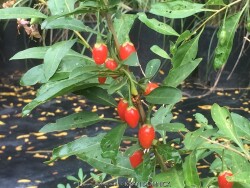
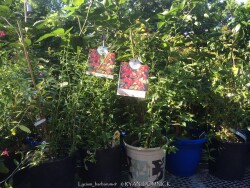
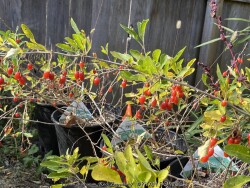
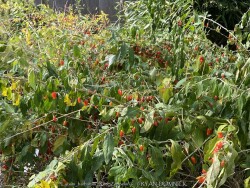
Plant Min Zone: 5a
Plant Max Zone: 9a
Sunlight: Full Sun
Water / Rainfall: Average
Soil Quality: Average, Rich
Bloom Season: Summer, Late Summer
Flower Color: Purple
Berry / Fruit Color: Red, Orangish Red
Spring Foliage Color: Green
Summer Foliage Color: Green
Fall Foliage Color: Green, Brown-Beige
Evergreen Foliage: No
Winter Interest: No
Scented Flowers: No
Drought Tolerance: Medium
Wet-Feet Tolerance: Medium
Humidity Tolerance: Medium
Wind Tolerance: Medium, High
Poor Soil Tolerance: Clay Soils, Rocky Soils, Alkaline Soils (high PH)
Height: 3' - 5'
Width: 3' - 5'
Growth Rate: Medium
Service Life: Medium: 3-5 years
Maintenance Need: High
Spreading Potential: Medium
Yearly Trimming Tips: Trim Shrub to Desired Size in Late Winter or Early Spring Before New Growth: Blooms on New Wood.
Plant Grouping Size: Small Grouping of 3-5
Best Side of House: South Exposure, West Exposure, East Exposure
Extreme Planting Locations: None
Ornamental Features: Easy to Eat Edibles
Special Landscape Uses: None
Possible Pest Problems: None
Plant Limitations: Lack of Ornamental Features, Needs Frequent Pruning / Trimming
Shippable in 2026: YES
It's easy to grow your own goji berries! Though they seem like something exotic and tricky to grow, goji berries are durable, productive plants that can be grown without any special sprays, fertilizers, or even fussy pruning. Just plant them in full sun, stake them, and wait to reap a bounty of bright red fruits in autumn. Red Zeppelin® Goji Berry (Lycium barbarum 'Red Zeppelin') was selected especially for its very large fruit, which makes harvesting easier and more fun. A few things to note about growing goji berries: 1. they prefer an alkaline (higher pH) soil and don't grow well in acidic conditions. 2. goji has a natural habit of creating lots of thin, vine-like stems. To save space and make harvesting easier, we recommend that you put a very sturdy stake near the shrub after planting, then bundle the stems around the stake, tying with sturdy twine so that about one-quarter of the tops of the branches cascade downward, like a fountain. 3. Goji is generally a heavy feeder, and regular fertilizing is recommended. Apply a tomato or rose fertilizer in spring and again in early summer. The fruits are a bit bitter, like a green pepper, when they are fresh. To develop sweetness, they must be dried. If you don't have a dehydrator, spread ripe berries in a single layer on a piece of newspaper in a cool, bright spot with good air circulation. After about a week, they will feel leathery and can be stored in the fridge or freezer. Maintenance Notes: Does best in well-drained neutral to alkaline soils. At planting time, sink a 1x1" wood stake near the plant and bundle the canes around it. Let the tips of the stems cascade down, like a fountain. Each spring, move the tied point up further along the stake so that about one-quarter of the growth is above the tie. Then cut the branch tips back by 4-6". This encourages lateral branching, which is where most of the flowering and fruiting takes place. In Eastern Kansas, typically our 40 inches of rainfall is sufficient without extra water. All Proven Winners® plants are legally propagated, healthy and vigorous, true to name, and tagged with color pictures and growing information.